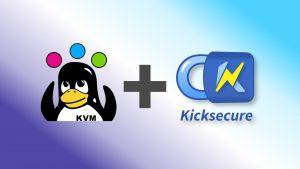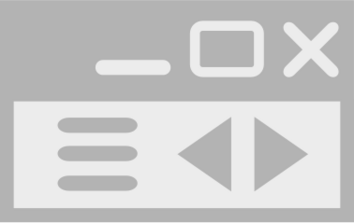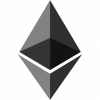Kicksecure for KVM with Xfce
| About this KVM Page Contributor maintained wiki page. | |
|---|---|
| Support Status | stable |
| Difficulty | medium |
| Contributor | HulaHoop |
| Support | Community support only! |

unofficial logo re-design for the KVM
 virtualizer
virtualizerThis is the KVM flavor of the Kicksecure project - a hardened and security centric version of Debian optimized for virtualized environments and clearnet usage.
 COMMUNITY SUPPORT ONLY :
THIS WHOLE WIKI PAGE
is only supported by the community. Kicksecure developers are very unlikely to provide free support for this content.
See Community Support for further information, including implications and possible alternatives.
COMMUNITY SUPPORT ONLY :
THIS WHOLE WIKI PAGE
is only supported by the community. Kicksecure developers are very unlikely to provide free support for this content.
See Community Support for further information, including implications and possible alternatives.
Contents
Introduction[edit]
Copy or share this direct link!
https://www.kicksecure.com/wiki/KVM#Introduction
Click below ↴ = Copy to Clipboard
[[KVM#Introduction|Introduction]]
Copy as Wikitext
[Introduction](https://www.kicksecure.com/wiki/KVM#Introduction)
for Discourse, reddit, GitHub
[Introduction](https://www.kicksecure.com/wiki/KVM#Introduction)
Copy as Markdown
[url=https://www.kicksecure.com/wiki/KVM#Introduction]Introduction[/url]
Copy as phpBB
Click below ↴ = Open social URL with share data








 We don't use embedded scripts
This share button is completely self-hosted by this webserver. No scripts from any of the social networks are embedded on this webserver. See also
Social Share Button.
We don't use embedded scripts
This share button is completely self-hosted by this webserver. No scripts from any of the social networks are embedded on this webserver. See also
Social Share Button.
Much of the warnings and use case instructions from the Kicksecure edition, such as running the OS headlessly or using shared folders, are applicable.
For more details about Kicksecure, check Kicksecure pages.
Support tickets should be forwarded to the KVM subforum![]()
.
Build from Scratch[edit]
Copy or share this direct link!
https://www.kicksecure.com/wiki/KVM#Build_from_Scratch
Click below ↴ = Copy to Clipboard
[[KVM#Build_from_Scratch|Build from Scratch]]
Copy as Wikitext
[Build from Scratch](https://www.kicksecure.com/wiki/KVM#Build_from_Scratch)
for Discourse, reddit, GitHub
[Build from Scratch](https://www.kicksecure.com/wiki/KVM#Build_from_Scratch)
Copy as Markdown
[url=https://www.kicksecure.com/wiki/KVM#Build_from_Scratch]Build from Scratch[/url]
Copy as phpBB
Click below ↴ = Open social URL with share data








 We don't use embedded scripts
This share button is completely self-hosted by this webserver. No scripts from any of the social networks are embedded on this webserver. See also
Social Share Button.
We don't use embedded scripts
This share button is completely self-hosted by this webserver. No scripts from any of the social networks are embedded on this webserver. See also
Social Share Button.
Advanced users are encouraged to build Kicksecure images for high security assurance.
Download Kicksecure[edit]
Copy or share this direct link!
https://www.kicksecure.com/wiki/KVM#Download_Kicksecure
Click below ↴ = Copy to Clipboard
[[KVM#Download_Kicksecure|Download Kicksecure]]
Copy as Wikitext
[Download Kicksecure](https://www.kicksecure.com/wiki/KVM#Download_Kicksecure)
for Discourse, reddit, GitHub
[Download Kicksecure](https://www.kicksecure.com/wiki/KVM#Download_Kicksecure)
Copy as Markdown
[url=https://www.kicksecure.com/wiki/KVM#Download_Kicksecure]Download Kicksecure[/url]
Copy as phpBB
Click below ↴ = Open social URL with share data








 We don't use embedded scripts
This share button is completely self-hosted by this webserver. No scripts from any of the social networks are embedded on this webserver. See also
Social Share Button.
We don't use embedded scripts
This share button is completely self-hosted by this webserver. No scripts from any of the social networks are embedded on this webserver. See also
Social Share Button.
![]() By downloading, you acknowledge that you have read, understood and agreed to our Terms of Service and License Agreement.
By downloading, you acknowledge that you have read, understood and agreed to our Terms of Service and License Agreement.
GUI
Copy or share this direct link!
https://www.kicksecure.com/wiki/KVM#GUI
Click below ↴ = Copy to Clipboard
[[KVM#GUI|GUI]]
Copy as Wikitext
[GUI](https://www.kicksecure.com/wiki/KVM#GUI)
for Discourse, reddit, GitHub
[GUI](https://www.kicksecure.com/wiki/KVM#GUI)
Copy as Markdown
[url=https://www.kicksecure.com/wiki/KVM#GUI]GUI[/url]
Copy as phpBB
Click below ↴ = Open social URL with share data








 We don't use embedded scripts
This share button is completely self-hosted by this webserver. No scripts from any of the social networks are embedded on this webserver. See also
Social Share Button.
We don't use embedded scripts
This share button is completely self-hosted by this webserver. No scripts from any of the social networks are embedded on this webserver. See also
Social Share Button.
- Kicksecure with Xfce graphical user interface (GUI).
- This version of Kicksecure is designed to run inside KVM.
Download Kicksecure Xfce for KVM (FREE!)

Optional: Digital signature verification.
Version: 17.2.8.5
- Digital signatures are a tool enhancing download security. They are commonly used across the internet and nothing special to worry about.
- Optional, not required: Digital signatures are optional and not mandatory for using Kicksecure, but an extra security measure for advanced users. If you've never used them before, it might be overwhelming to look into them at this stage. Just ignore them for now.
- Learn more: Curious? If you are interested in becoming more familiar with advanced computer security concepts, you can learn more about digital signatures here digital software signatures.
OpenPGP
Copy or share this direct link!
https://www.kicksecure.com/wiki/KVM#OpenPGP
Click below ↴ = Copy to Clipboard
[[KVM#OpenPGP|OpenPGP]]
Copy as Wikitext
[OpenPGP](https://www.kicksecure.com/wiki/KVM#OpenPGP)
for Discourse, reddit, GitHub
[OpenPGP](https://www.kicksecure.com/wiki/KVM#OpenPGP)
Copy as Markdown
[url=https://www.kicksecure.com/wiki/KVM#OpenPGP]OpenPGP[/url]
Copy as phpBB
Click below ↴ = Open social URL with share data








 We don't use embedded scripts
This share button is completely self-hosted by this webserver. No scripts from any of the social networks are embedded on this webserver. See also
Social Share Button.
We don't use embedded scripts
This share button is completely self-hosted by this webserver. No scripts from any of the social networks are embedded on this webserver. See also
Social Share Button.
signify
Copy or share this direct link!
https://www.kicksecure.com/wiki/KVM#signify
Click below ↴ = Copy to Clipboard
[[KVM#signify|signify]]
Copy as Wikitext
[signify](https://www.kicksecure.com/wiki/KVM#signify)
for Discourse, reddit, GitHub
[signify](https://www.kicksecure.com/wiki/KVM#signify)
Copy as Markdown
[url=https://www.kicksecure.com/wiki/KVM#signify]signify[/url]
Copy as phpBB
Click below ↴ = Open social URL with share data








 We don't use embedded scripts
This share button is completely self-hosted by this webserver. No scripts from any of the social networks are embedded on this webserver. See also
Social Share Button.
We don't use embedded scripts
This share button is completely self-hosted by this webserver. No scripts from any of the social networks are embedded on this webserver. See also
Social Share Button.
CLI
Copy or share this direct link!
https://www.kicksecure.com/wiki/KVM#CLI
Click below ↴ = Copy to Clipboard
[[KVM#CLI|CLI]]
Copy as Wikitext
[CLI](https://www.kicksecure.com/wiki/KVM#CLI)
for Discourse, reddit, GitHub
[CLI](https://www.kicksecure.com/wiki/KVM#CLI)
Copy as Markdown
[url=https://www.kicksecure.com/wiki/KVM#CLI]CLI[/url]
Copy as phpBB
Click below ↴ = Open social URL with share data








 We don't use embedded scripts
This share button is completely self-hosted by this webserver. No scripts from any of the social networks are embedded on this webserver. See also
Social Share Button.
We don't use embedded scripts
This share button is completely self-hosted by this webserver. No scripts from any of the social networks are embedded on this webserver. See also
Social Share Button.
- Kicksecure with command line interface (CLI).
- This version of Kicksecure is designed to run inside KVM.
- Kicksecure with CLI is a version suited for advanced users -- those who want Kicksecure without a graphical user interface (GUI).
Download Kicksecure CLI for KVM (FREE!)

Optional: Digital signature verification.
Version: 17.2.8.5
- Digital signatures are a tool enhancing download security. They are commonly used across the internet and nothing special to worry about.
- Optional, not required: Digital signatures are optional and not mandatory for using Kicksecure, but an extra security measure for advanced users. If you've never used them before, it might be overwhelming to look into them at this stage. Just ignore them for now.
- Learn more: Curious? If you are interested in becoming more familiar with advanced computer security concepts, you can learn more about digital signatures here digital software signatures.
OpenPGP
Copy or share this direct link!
https://www.kicksecure.com/wiki/KVM#OpenPGP_2
Click below ↴ = Copy to Clipboard
[[KVM#OpenPGP_2|OpenPGP]]
Copy as Wikitext
[OpenPGP](https://www.kicksecure.com/wiki/KVM#OpenPGP_2)
for Discourse, reddit, GitHub
[OpenPGP](https://www.kicksecure.com/wiki/KVM#OpenPGP_2)
Copy as Markdown
[url=https://www.kicksecure.com/wiki/KVM#OpenPGP_2]OpenPGP[/url]
Copy as phpBB
Click below ↴ = Open social URL with share data








 We don't use embedded scripts
This share button is completely self-hosted by this webserver. No scripts from any of the social networks are embedded on this webserver. See also
Social Share Button.
We don't use embedded scripts
This share button is completely self-hosted by this webserver. No scripts from any of the social networks are embedded on this webserver. See also
Social Share Button.
signify
Copy or share this direct link!
https://www.kicksecure.com/wiki/KVM#signify_2
Click below ↴ = Copy to Clipboard
[[KVM#signify_2|signify]]
Copy as Wikitext
[signify](https://www.kicksecure.com/wiki/KVM#signify_2)
for Discourse, reddit, GitHub
[signify](https://www.kicksecure.com/wiki/KVM#signify_2)
Copy as Markdown
[url=https://www.kicksecure.com/wiki/KVM#signify_2]signify[/url]
Copy as phpBB
Click below ↴ = Open social URL with share data








 We don't use embedded scripts
This share button is completely self-hosted by this webserver. No scripts from any of the social networks are embedded on this webserver. See also
Social Share Button.
We don't use embedded scripts
This share button is completely self-hosted by this webserver. No scripts from any of the social networks are embedded on this webserver. See also
Social Share Button.
Note: Save your download to your usual ~/Downloads folder.
Decompress[edit]
Copy or share this direct link!
https://www.kicksecure.com/wiki/KVM#Decompress
Click below ↴ = Copy to Clipboard
[[KVM#Decompress|Decompress]]
Copy as Wikitext
[Decompress](https://www.kicksecure.com/wiki/KVM#Decompress)
for Discourse, reddit, GitHub
[Decompress](https://www.kicksecure.com/wiki/KVM#Decompress)
Copy as Markdown
[url=https://www.kicksecure.com/wiki/KVM#Decompress]Decompress[/url]
Copy as phpBB
Click below ↴ = Open social URL with share data








 We don't use embedded scripts
This share button is completely self-hosted by this webserver. No scripts from any of the social networks are embedded on this webserver. See also
Social Share Button.
We don't use embedded scripts
This share button is completely self-hosted by this webserver. No scripts from any of the social networks are embedded on this webserver. See also
Social Share Button.
Use tar to decompress the archive.
Click = Copy Copied to clipboard! tar -xvf Kicksecure*.libvirt.xz
Do not use unxz! Extract the images using tar.
Importing Kicksecure VM Template[edit]
Copy or share this direct link!
https://www.kicksecure.com/wiki/KVM#Importing_Kicksecure_VM_Template
Click below ↴ = Copy to Clipboard
[[KVM#Importing_Kicksecure_VM_Template|Importing Kicksecure VM Template]]
Copy as Wikitext
[Importing Kicksecure VM Template](https://www.kicksecure.com/wiki/KVM#Importing_Kicksecure_VM_Template)
for Discourse, reddit, GitHub
[Importing Kicksecure VM Template](https://www.kicksecure.com/wiki/KVM#Importing_Kicksecure_VM_Template)
Copy as Markdown
[url=https://www.kicksecure.com/wiki/KVM#Importing_Kicksecure_VM_Template]Importing Kicksecure VM Template[/url]
Copy as phpBB
Click below ↴ = Open social URL with share data








 We don't use embedded scripts
This share button is completely self-hosted by this webserver. No scripts from any of the social networks are embedded on this webserver. See also
Social Share Button.
We don't use embedded scripts
This share button is completely self-hosted by this webserver. No scripts from any of the social networks are embedded on this webserver. See also
Social Share Button.
The supplied XML files serve as a description for libvirt and define the properties of a Kicksecure VM and the networking it should have.
1. Kicksecure works with the network named default out of the box.
2. Import the Kicksecure image.
Click = Copy Copied to clipboard! virsh -c qemu:///system define Kicksecure*.xml
Moving the Kicksecure Image File[edit]
Copy or share this direct link!
https://www.kicksecure.com/wiki/KVM#Moving_the_Kicksecure_Image_File
Click below ↴ = Copy to Clipboard
[[KVM#Moving_the_Kicksecure_Image_File|Moving the Kicksecure Image File]]
Copy as Wikitext
[Moving the Kicksecure Image File](https://www.kicksecure.com/wiki/KVM#Moving_the_Kicksecure_Image_File)
for Discourse, reddit, GitHub
[Moving the Kicksecure Image File](https://www.kicksecure.com/wiki/KVM#Moving_the_Kicksecure_Image_File)
Copy as Markdown
[url=https://www.kicksecure.com/wiki/KVM#Moving_the_Kicksecure_Image_File]Moving the Kicksecure Image File[/url]
Copy as phpBB
Click below ↴ = Open social URL with share data








 We don't use embedded scripts
This share button is completely self-hosted by this webserver. No scripts from any of the social networks are embedded on this webserver. See also
Social Share Button.
We don't use embedded scripts
This share button is completely self-hosted by this webserver. No scripts from any of the social networks are embedded on this webserver. See also
Social Share Button.
The XML files are configured to point to the default storage location of /var/lib/libvirt/images. The following steps move the images there so the machines can boot.
Note: Changing the default location may cause conflicts with SELinux, which will prevent the machines from booting.
It is recommended to move the image file instead of copying it.
Click = Copy Copied to clipboard! sudo mv Kicksecure*.qcow2 /var/lib/libvirt/images/Kicksecure.qcow2
Footnotes[edit]
Copy or share this direct link!
https://www.kicksecure.com/wiki/KVM#Footnotes
Click below ↴ = Copy to Clipboard
[[KVM#Footnotes|Footnotes]]
Copy as Wikitext
[Footnotes](https://www.kicksecure.com/wiki/KVM#Footnotes)
for Discourse, reddit, GitHub
[Footnotes](https://www.kicksecure.com/wiki/KVM#Footnotes)
Copy as Markdown
[url=https://www.kicksecure.com/wiki/KVM#Footnotes]Footnotes[/url]
Copy as phpBB
Click below ↴ = Open social URL with share data








 We don't use embedded scripts
This share button is completely self-hosted by this webserver. No scripts from any of the social networks are embedded on this webserver. See also
Social Share Button.
We don't use embedded scripts
This share button is completely self-hosted by this webserver. No scripts from any of the social networks are embedded on this webserver. See also
Social Share Button.
Copy as Wikitext [Kicksecure for KVM with Xfce](https://www.kicksecure.com/wiki/KVM)
for Discourse, reddit, GitHub [Kicksecure for KVM with Xfce](https://www.kicksecure.com/wiki/KVM)
Copy as Markdown [url=https://www.kicksecure.com/wiki/KVM]Kicksecure for KVM with Xfce[/url]
Copy as phpBB Click below ↴ = Open social URL with share data








 We don't use embedded scripts
This share button is completely self-hosted by this webserver. No scripts from any of the social networks are embedded on this webserver. See also
Social Share Button.
We don't use embedded scripts
This share button is completely self-hosted by this webserver. No scripts from any of the social networks are embedded on this webserver. See also
Social Share Button.

We believe security software like Kicksecure needs to remain Open Source and independent. Would you help sustain and grow the project? Learn more about our 12 year success story and maybe DONATE!

 GUI
GUI CLI
CLI












